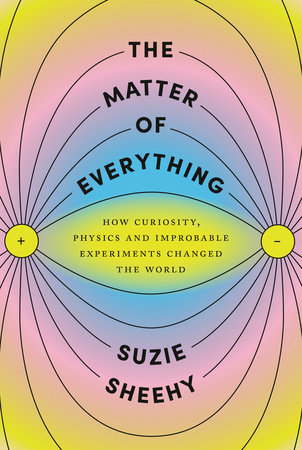The Matter of Everything: How Curiosity, Physics, and Improbable Experiments Changed the World
- By Suzie Sheehy
- Knopf
- 320 pp.
- Reviewed by Stephen Case
- January 11, 2023
A marvelous tale of particle beams and their harnessers.

Do scientists shout “Eureka!” when making major discoveries? No, biochemist and prolific author Isaac Asimov purportedly said. Instead, they mutter, “That’s funny.”
One epic that’s funny event cropped up in 1895, when German physicist Wilhelm Röntgen, tinkering with a glass tube, forever revolutionized medicine and inspired a subsequent cornucopia of jaw-dropping innovations. This we learn from the splendid The Matter of Everything: How Curiosity, Physics, and Improbable Experiments Changed the World by Suzie Sheehy, holder of a doctorate in physics from — and the title of Royal Society University Research Fellow at — Oxford, where she investigates breakthrough particle-accelerator technologies.
What did Röntgen do, exactly? Using a vacuum pump, he sucked the air out of the tube, hooked up electricity, and turned it on. The tube lit up, as expected. However — surprise, surprise — on the far side of the room, there glowed an unconnected phosphorescent screen. Action at a distance!
That’s funny.
Röntgen surmised that electricity in the tube had generated “X-rays.” Streaming out, they energized the distant screen. He soon slid his wife’s hand between his electrified glass tube and a photographic plate. “I have seen my death!” she supposedly declared, dumbfounded, when later beholding the eerie image of her finger bones. Within weeks, eager physicians put Röntgen’s device to work on patients to confirm bones were broken or to locate deeply buried bullets. (Later, they would discover X-ray radiation also cures some cancers.)
In 1897, just a year after Röntgen announced his findings, British scientist J.J. Thomson shot down the ancient notion that atoms are indivisible. Whizzing around inside Röntgen’s glass tubes were, he learned, exceptionally tiny, light, negatively charged particles that buzzed out from inside atoms. (That’s funny.) This was, writes Sheehy:
“[The] discovery of the electron, the first sub-atomic particle…Between them, Röntgen and Thomson, using a single piece of equipment, had found two entirely new aspects of nature which had never been seen before.”
Shortly thereafter, three other researchers shot beams of particles through gold foil. The beams blew straight through…except that once every 8,000 times, a particle bounced back. “It was almost as incredible as if you fired a 15-inch shell at a piece of tissue paper and it came back,” one of the researchers reflected.
“But how could that be?” asks Sheehy. “How could [particles] be deflected by tiny electrons or the diffuse positive charge of the atom?” The answer? “The atom…had at its core a tiny nucleus of positive charge, dense enough that it could deflect [the particles] when they came close.”
Thus did this unconnected gaggle of five fin de siècle experimental physicists kick off the atomic age, with its world-changing, still-being-revealed wonders and terrors. One such wonder was the magnetron, a souped-up descendant of Röntgen’s glass tube once used in radar. Back in 1945, a radar engineer had a Mr. Goodbar in his pocket. When he was fiddling with his magnetron, the chocolate suddenly melted into a gooey mess. That’s funny. Since then, “Microwave ovens powered by magnetrons [have become] the everyday household appliances we all know.”
Trials in other labs led to the creation of particle-beam accelerators (or cyclotrons). No mere nerdy curiosities, “The most likely place you will find a cyclotron today is…in the basement of a hospital.” The machines create radioisotopes that “treat diseases and diagnose when our…blood flow [and]…organ functions aren’t working properly.”
But this technology has hardly remained behind clinic walls. “From the chips in our phones and computers, to the tyres on our cars, to the shrink wrap on our food,” writes Sheehy, “we are surrounded with objects that have been strengthened or…improved using particle beams.”
Today, the cutting edge of particle-beam science is the much-ballyhooed Large Hadron Collider at CERN in Switzerland. This enormous particle-collision contraption descends directly from the gold-foil experiment that first found the atomic nucleus and continues the same work. What’s it good for? Too much to get into here, but consider this: The collider’s first truly life-altering innovation was fueled by the reams upon reams of data the machine itself generated.
In the 1980s, stumped by just how to transmit all that data across the globe, project leaders tasked lowly grad student Tim Berners-Lee with finding a solution. His resulting memo proposed “bringing together new technologies in computers, networks and hypertext into a system.” If what he was describing sounds familiar, it should. Spurred by the output of the Large Hadron Collider, Berners-Lee had just invented “the World Wide Web,” writes Sheehy. “Yes, the World Wide Web.”
That’s funny.
Stephen Case is a member of the Independent’s board of directors.

_80_125.png)